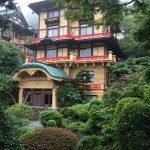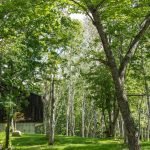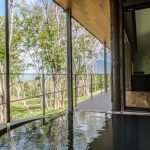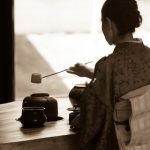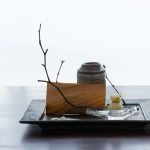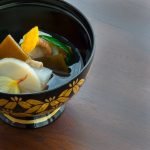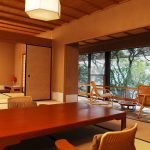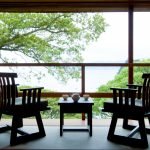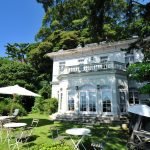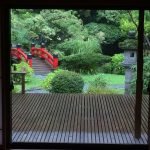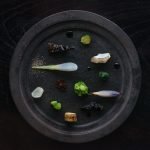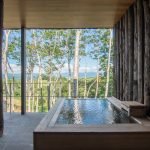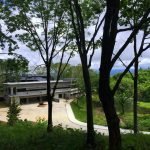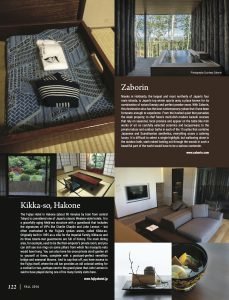LuxeGetaways Magazine – Fall 2016 | A combination of centuries-honed hospitality, fine cuisine, calmness and traditional pampering; the Japanese inn (the ryokan) is more than a form of accommodation; it is an experience. From the bows that greet you upon arrival, to your evening soak in the communal hot-spring baths, the ryokan immerses you in traditional Japanese culture like nothing else.
With the welcome bows and formalities out of the way, it begins with your room; where (more often than not) you will find the classic blend of tatami-mat flooring, shoji paper screen doors, ikebana flower arrangements, calligraphy wall hangings and a low table at which your dinner is often served in many of the ryokan. The bed (a futon) will be rolled up in the cupboard upon arrival, where it will stay until the staff arrive to make it up in a silent blur just after dinner. And laid out for you will be your outfit for the duration of the stay, a cotton yukata (a lightweight, one-piece gown with a sash) that will allow you to shed your clothes, and with it say goodbye to the world outside.
Then comes the first opportunity to try the baths, which are usually a selection of large communal, but gender-separated tubs and rock pools that are filled with piping-hot natural spring waters believed to alleviate all sorts of ailments. Whether they are inside, or outside surrounded by nature; at the very least, they relax and soothe every muscle. For most Japanese travelers (and for me), the baths define a ryokan just as much as the cuisine that follows. And that meal is usually a very elaborate affair, with a succession of small, beautifully presented courses based around seasonal produce and locally sourced seafood and meat (a style of cuisine called kaiseki). High-end ryokan or not, the kaiseki is like an A-Z of classic Japanese cuisine, featuring such things as delicate tempura, subtly flavored tofu, fresh sashimi (sliced raw fish), perhaps a little melt-in-the-mouth Kobe beef and many other regional delicacies. The odd thing is, you rarely feel like you have over eaten, and yet never feel undernourished. After staying at dozens upon dozens of ryokan, I still do not know how the chefs consistently manage that ideal level of satisfaction. What I do know, however, is that the relax-bath-eat-sleep formula makes the ryokan Japan’s ultimate traditional indulgence.
THREE OF THE FINEST
KAI Atami
A 45-minute bullet train ride from central Tokyo, in the hot-springs resort town of Atami, the cliff-top KAI is the quintessential traditional ryokan. As you might expect of a classic 160-year-old property like this, the 16 rooms here feature tatami flooring and a traditional futon put down at night. This is when the sound of the ocean lapping the shore in the distance seems to grow louder and more soothing, but the KAI then goes beyond the norm. Come evening, the sumptuous multi-course dinner, which is largely based around locally caught seafood, is one of the most creative ryokan diners I have ever experienced; with signature dishes like whole red snapper and clams steamed in eight spices combined with more classic kaiseki flavors. This is followed by a nightly geisha performance, where you can play games with a local geisha, as well as watch her perform traditional dances and other performing arts. To wrap up the night, you then finish with a soak in the large, open-air cedar baths overlooking Sagami Bay, before retiring to the outdoor lounge for a nightcap. www.kai-atami.jp
Kikka-so, Hakone
The Fujiya Hotel in Hakone (about 90 minutes by train from central Tokyo) is considered one of Japan’s classic Western-style hotels. It is a gracefully aging Meiji-era structure with a guestbook that includes the signatures of VIPs like Charlie Chaplin and John Lennon – but often overlooked is the Fujiya’s ryokan annex, called Kikka-so. Originally built in 1895 as a villa for the Imperial Family, Kikka-so and its three tatami-mat guestrooms are full of history. The main dining area, for example, used to be the then-emperor’s private room, and you can still see iron rings on some pillars from which his mosquito nets would have hung. You can also have his once-private stroll garden all to yourself at times, complete with a postcard-perfect vermillion bridge and seasonal blooms. And to cap that off, you have access to the Fujiya itself, where the old bar provides an old colonial setting for a cocktail or two, perhaps next to the grand piano that John Lennon is said to have played during one of his many family visits here. www.fujiyahotel.jp/en
Zaborin
Niseko in Hokkaido, the largest and most northerly of Japan’s four main islands, is Japan’s top winter sports area; a place known for its combination of natural beauty and perfect powder snow. With Zaborin, this destination also has the best contemporary ryokan that I have been fortunate enough to experience. From the hushed quiet that pervades the sleek property; to chef Seno’s multi-dish modern kaiseki courses that rely on seasonal, local produce and appear on the table like mini works of art on carefully selected ceramics and lacquerware; to the private indoor and outdoor baths in each of the 15 suites that combine Japanese and Scandinavian aesthetics, everything oozes a calming luxury. It is difficult to select a single highlight, but wallowing alone in the outdoor bath, stark naked looking out through the woods in such a beautiful part of the world would have to be a serious contender. www.zaborin.com/en

